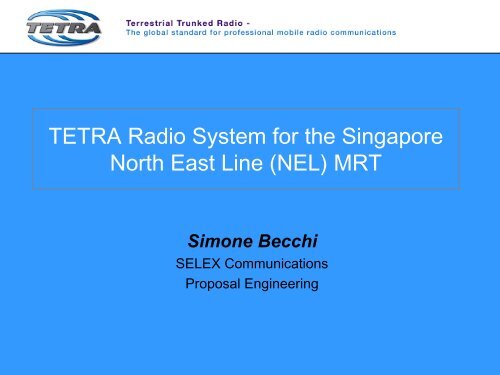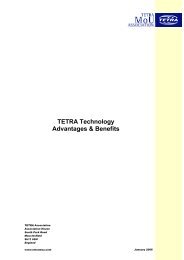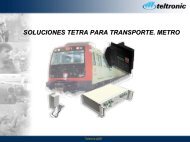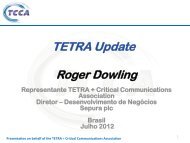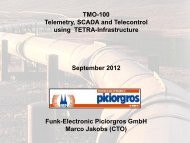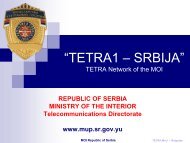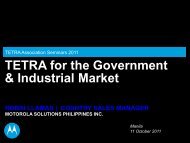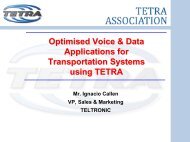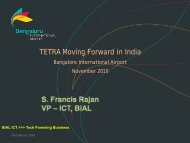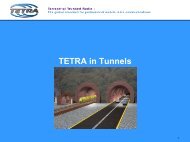Case Study - Singapore Metro - tetra
Case Study - Singapore Metro - tetra
Case Study - Singapore Metro - tetra
- No tags were found...
Create successful ePaper yourself
Turn your PDF publications into a flip-book with our unique Google optimized e-Paper software.
TETRA Radio System for the <strong>Singapore</strong>North East Line (NEL) MRTSimone BecchiSELEX CommunicationsProposal Engineering
Agenda‣ Mass Transit & Open Systems‣ The NEL Overview‣ Phases‣ The System Architecture & Configuration‣ The TETRA Features & Resiliencies‣ Project Highlights‣ The Challenges3 sept 2008TETRA: The Next Ten YearsSlide 2
Communications for Transportations:Mass Transit Main Drivers‣Modern metropolitan areas are evolvingto complex systems, with population andservices demand increase‣Social development and modernizationrequire adoption of new applications oftechnologies‣Maintenance costs optimization3 sept 2008TETRA: The Next Ten YearsSlide 3
Mass Transit Services requiredPassengers InformationCommunicationSystemSecurity ApplicationsSub-Systems IntegrationVehicle MaintenanceStaff Communications3 sept 2008TETRA: The Next Ten YearsSlide 4
TETRA: an Open SystemTrain/Bus Management Systems canbe based on:– a standard PEI interface (ETS EN 300392-5)– a proprietary interface to the vehicularstation control panelDispatcher applications can be basedon:– an API for windows O.S.– a “TCP Server” interface, whichexports the API on TCP/IP, supporting:calls, subscriber management andalarms3 sept 2008TETRA: The Next Ten YearsSlide 5
The integration of NEL to the MRT (purple line)3 sept 2008TETRA: The Next Ten YearsSlide 6
The NEL Overview 1/3‣The North East Line is one of theMRT lines of the whole RapidTransit System of <strong>Singapore</strong>.‣NEL comprises of 16 Stations,one (1) Operation Control Centre,and one (1) Depot for theoperations of new-driverless 25six-car trains.3 sept 2008TETRA: The Next Ten YearsSlide 7
The NEL Overview 2/3‣The NEL is the first new majorMRT line built in <strong>Singapore</strong> sincethe completion of the main MRTnetwork in 1990. It costs $5billion, and is the largest and mostcomplex public works project inthe history of <strong>Singapore</strong>‣NEL has started revenueservices on 20 th June 20033 sept 2008TETRA: The Next Ten YearsSlide 8
The NEL Overview 3/3‣ NEL is huge and a complex project with diversified contractors:– Alstom for Trains and Signaling– Syseca/Thales for ISCS (OCC)– NESIC for Communication System, with Selex as subcontractorfor TETRA Mobile Radio and Trainborne Computer Interface (TCI)– Mitsubishi for Power LineNEL TRAINS IN STABLING TRACK DEPOT3 sept 2008TETRA: The Next Ten YearsSlide 9
Integration & Implementation Phase‣ Project kick.off in 1997‣ Design completed in 1998‣ The integration platform with OCC based on 1 SCN and 2 BS’s wereinstalled in Syseca/Thales premises located in Paris on May 2000 for ISCS-TETRA integration‣ The first train and locomotive radio equipment were despatched on June2000‣ The Test Tracking System in Valenciennes has been commissioned onNovember 2000‣ The equipment despatch in <strong>Singapore</strong> was completed on May 2001‣ The System Commissioning in <strong>Singapore</strong> was started in January 2002;‣ Train Run Test was completed in until May 2003‣ Revenue service opened on 20th June 2003.3 sept 2008TETRA: The Next Ten YearsSlide 10
TETRA System ArchitectureSCNISCS - OCCroomPassengerAnnouncementsPABXSignalingPassengerInformationSystemBS atDepotSDH NetworkA ringSDH NetworkB ringClosedCircuit TVGWGWBS1GWBS2…GWBS163 sept 2008TETRA: The Next Ten YearsSlide 11
TETRA Key Elements‣ 1 SCN in redundant configuration‣ 17 Base Stations 380-400 MHz 2 carrierswith redundant site controller and redundanttelephonic Gateway‣ BS-fallback radio operation, including localdispatching and PABX capability,‣ Network Management System (NMS)‣ Redundant link to BS‣ 58 vehicular VS2000S‣ 150 hand-held PUMA-T‣ 50 Trainborne Computer Interface‣ Fully integrated with Integrated SupervisoryControl System (ISCS)3 sept 2008TETRA: The Next Ten YearsSlide 12
On-BoardConfiguration 1/2Train InformationManagement System(TIMS)Audio MatrixPublic AnnouncementClose Circuit TVPassenger Information SystemTrain-ComputerInterfaceTrain-ComputerInterfaceMSVS2000-S and TCI: mobile radio and Trainborne customization for railways Services Two remote control panels, radio and TCI at the extremities of the train with high noise immunityconnection to the same radio equipment based on specific connectors and RS422. Interfaces between TETRA vehicular and TCI are based on PEI Standard software.3 sept 2008TETRA: The Next Ten YearsSlide 13
On-Board Configuration 2/2Connection Unit translates interface from TrafficController (using MASC) to PEITETRAAntenna30 K /dag1 SDS/minDrift larmTicket machineAutomatictraffic/passengercounterOn-boardcomputerTrafic controllerNot planned FAS1Speaker PASpeaker PAoutsideConnection unitTETRARadioGUIVisible alarm buttonHidden alarm buttonTime schedule 500 K data/month3 SDS/minutTransponderPA = passenger announcementsExisting interfaceTo Mobitex calledMASC3 sept 2008TETRA: The Next Ten YearsSlide 14
TETRA Key Features 1/2‣ Voice‣ Data– Public Addressing by OCC– Trainborne Passenger Emergency Call from Train– Maintenance Group Management– Pre-emptive emergency call– Short Data Service 1 MCCH and 2 SCCH for increased SDS, with Multi-slotscircuit and packet mode data transmission.– Passenger Information Display (PIS) Download– Train Diagnostic and Alarm– Simultaneous voice and SDS (uplink and downlink)‣ Connection and Integration with ISCS– Operation Control Center with I/F at SCN level– Passenger Station Level with I/F at Base Station Level in normal operation andfallback mode3 sept 2008TETRA: The Next Ten YearsSlide 15
TETRA Key Features 2/2‣ TCI communicate with VS2000 trough a AT command software library ported inQNX Operating System Dispatcher - ISCS capability‣ Up to 16 simultaneous calls (group or individual, also full duplex) for eachdispatcher operator‣ Connection to PABX with I/F at SCN level and at BS level in fall-back‣ Dynamic Group Generation, Group Patching‣ Call establishment authorisation‣ Discrete Listening‣ Forced Call Termination‣ CCTV Control by ISCS through Trainborne equipment‣ ISCS and PSTN/PABX interface at Base Station‣ Double front panel of vehicular radio for locomotive‣ IP 52 / IP 543 sept 2008TETRA: The Next Ten YearsSlide 16
NEL TETRA Network ResilienceNEL TETRA Network provide a highly resilient system:All network elements support duplicated links to the SCN or BS ringsAll network elements are redundant in their main parts, e.g.:– BS support redundant MPU, backup TRX, redundant GW– SCN support redundant control logic, redundant GW andredundant Administrative Server– redundant connections to the dispatcher interface are providedat SCN, CRS and BS levelVery short or zero changeover timings, assuring minimum loss ofservice in case of faults.3 sept 2008TETRA: The Next Ten YearsSlide 17
NEL TETRA Network Highlights 1/2Distribuited NetworkIn normal mode of operations with the presence of Gateway at every BS wehave a distribuited network to the Pabx interfacesFallback OperationIn Fallback mode of operations every operator is still reachable thanks again tothe same GatewaysSingle Train ManagementEach train has two VS onboard, configured as a group.The association between the group and the train number is made at ISCS levelLine ManagementTrains on the same line / direction can be grouped together with Group Patching orDGNAStation ManagementA group call involving all trains under the coverage of a BS can be made with theGOADGNA, Groups Patching and GOA are key features provided by TETRA3 sept 2008TETRA: The Next Ten YearsSlide 18
NEL TETRA Network Highlights 2/2Trains are driverless: any interaction between the OCC and train is basedon SDSSDS are used for:– Train onboard equipment status reporting (1 SDS from train toOCC every 6 s)– Train onboard equipment configuration (status SDS from OCCto train)– Passenger Information System (SDS from OCC to train)– Passenger Emergency Call (“callback” SDS from train to OCC,activated when the PEC button is pressed)Concurrency between speech calls and SDS is a key feature provided by TETRA3 sept 2008TETRA: The Next Ten YearsSlide 19
Project Challenges‣ Project Management - The great challenge to the project managementteam to coordinate plans, to satisfy and to deliver the works for a highlydemanding requirement of the customer without any delay.‣ Integration & Coordination - The enormous and complicated amount ofworks for coordination and integration with the diversified projectcontractors. To complete the project is a real great challenge for every keyplayer of the project.‣ Technical Challenge – One difficult and specific part of the system designis the consideration of the tunnel environment for the Radio Wavepropagation as the major element of TETRA and Commercial radioapplications. (i.e. A very high noise floor factor of -95dBm compare to -105dBm for the typical environment applications.)‣ TETRA Specific - All the Tetra Network element including peripherals havebeen fully qualified in accordance to the British Railway Standard.‣ Software Quality - The software development process and the specificproject has been assessed by a nominated Auditor.3 sept 2008TETRA: The Next Ten YearsSlide 20
The NEL TETRA Radio System<strong>Singapore</strong> North East MRT LineEnd of presentationThank You!


